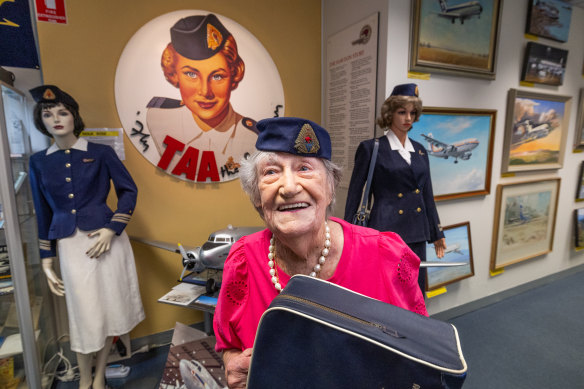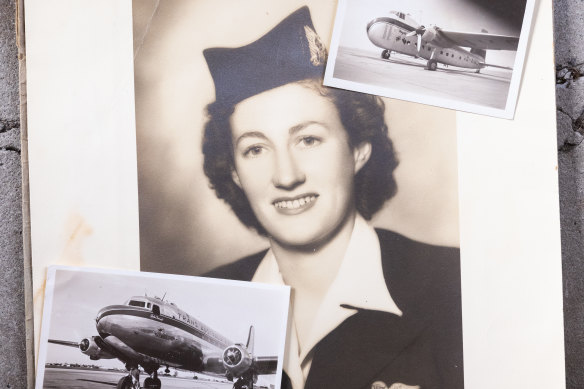By Carolyn Webb
Being an air hostess in the 1940s was not for the fainthearted, but for three years Elizabeth Reid proved she had the right stuff as one of Trans Australia Airlines’ (TAA) first “hosties”.
You had to be immaculately groomed while serving tea and soupy food to 21 customers in a DC-3 aeroplane, which flew low – just 8000 feet – and didn’t rise above often stomach-churning turbulence.

Elizabeth Reid, aged 100, at the TAA Museum in Airport West on Thursday.Credit: Jason South
Reid – now 100 – was among the first hostesses at TAA, working from 1946 to 1949.
On her first visit to the TAA Museum on Thursday, she recounted how she would clean up nervy passengers’ vomit, give out blankets and deal with drunks.
“You didn’t stop,” she said.
Flying from Adelaide to Darwin took all day, landing five times to refuel and pick up passengers at outback dots on the map such as Oodnadatta and Daly Waters.
Being hardy was handy for a hostie – and the centenarian from Beaumaris proved her mettle once again on Thursday.

Elizabeth Reid during her hostie era.Credit: Jason South
As the outside temperature passed 35 degrees, Reid refused to cancel her visit to the museum, which is located in a Qantas flight-training building in Airport West.
Reid, nee Hudson, was rewarded with a trip down memory runway.
Her family had donated photos of her and her late sister Rosemary – also a 1940s TAA hostie – and editions of a TAA staff magazine, This Air Age, from that era.
Reid enjoyed seeing the displays (mostly tended by former TAA employees) and talking shop with volunteer Libby Watkins, herself a hostie in the late ’60s.
Both Reid and Watkins had to resign when they married.
Watkins said Reid took a rare path, becoming a hostess in the ’40s. “They were amazing. They were the groundbreakers. There were very few of them in comparison to today.”
Of Reid’s visit, she said: “I think it’s fabulous. I think she’s the most amazing lady. Part of our history.”
Reid said she loved being an air hostess. She joined TAA with a friend, Shirley Marks, and airport ground crew would teasingly call them “the terrible twins” on two-way radio. In her time off, she went to Perth’s Cottesloe Beach or out for dinner in Sydney.
Most passengers were nice, Reid recounted, but once she and Shirley had “the most revolting passengers, just nasty people, they complained about everything”.
“On a trip to Auckland [with another airline] … we had to disinfect the aircraft at the end of the flight. And I went up and down spraying and saturated these two awful people. I got my own back.”
Famous passengers included the actors Vivien Leigh and Laurence Olivier, then-PM Ben Chifley, and the acclaimed deaf and blind American author Helen Keller.
Reid even served Essendon football players flying to Perth, including the legendary Dick Reynolds. “They were very nice,” she said.
But she hated trips from Canberra to Melbourne, “because it would be late at night and half of them would be full [of alcohol] before they even got on the aircraft. I’m talking about our politicians”.
Upon seeing exhibits featuring the smart navy TAA uniform, she remarked: “It’s wonderful.”
There were models of those early DC-3s, in-flight menus from 1946, an unused packet of pantyhose, TAA toothpicks, and even a girdle of the type hosties had to wear.
Reid’s visit to the museum came about when her niece, Katrina Burke, who worked in TAA’s advertising department in the ’80s, was going through the papers of her late mother Rhona, Elizabeth’s sister.
Burke said the museum visit had given her “Aunty Betty” something to look forward to, “to relive what was a really good time in her life”.
Reid doesn’t regret becoming a hostie. “I made a lot of friends. I remember everywhere I went. We just had a lot of fun.”